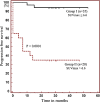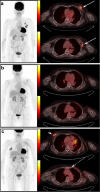Prognostic Value of Primary Tumor Uptake on F-18 FDG PET/CT in Patients with Invasive Ductal Breast Cancer
- PMID: 24899990
- PMCID: PMC4043019
- DOI: 10.1007/s13139-011-0081-0
Prognostic Value of Primary Tumor Uptake on F-18 FDG PET/CT in Patients with Invasive Ductal Breast Cancer
Abstract
Purpose: To determine the prognostic implications of pretreatment F-18 FDG PET/CT in patients with invasive ductal breast cancer (IDC), we evaluated the relationship between FDG uptake of the primary tumor and known prognostic parameters of breast cancer. Prognostic significance of tumoral FDG uptake for the prediction of progression-free survival (PFS) was also assessed.
Materials and methods: Fifty-five female patients with IDC who underwent pretreatment F-18 FDG PET/CT were enrolled. The maximum standardized uptake value of the primary tumor (pSUVmax) was compared with clinicopathological parameters including tumor size, grade, estrogen receptor (ER), progesterone receptor (PR), human epidermal growth factor receptor2 (HER2), axillary lymph node (LN) metastasis, and stage. The prognostic value of pSUVmax for PFS was assessed using the Kaplan-Meier method.
Results: A high pSUVmax was significantly related to a higher stage of tumor size (P < 0.05), grade (P < 0.001), and stage (P < 0.001). pSUVmax was significantly higher in ER-negative tumors (P < 0.001), PR-negative tumors (P < 0.001), and positive LN metastasis (P < 0.01), but not different according to HER2 status. pSUVmax was significantly higher in patients with progression compared to patients who were disease-free (10.6 ± 5.1 vs. 4.7 ± 3.5, P < 0.001). A receiver-operating characteristic curve demonstrated a pSUVmax of 6.6 to be the optimal cutoff for predicting PFS (sensitivity; 86.7%, specificity; 82.5%). The patients with a high pSUVmax (more than 6.6) had significantly shorter PFS compared to patients with a low pSUVmax (P < 0.0001).
Conclusions: pSUVmax on pretreatment F-18 FDG PET/CT could be used as a good surrogate marker for the prediction of progression in patients with IDC.
Keywords: F-18 FDG PET/CT; Invasive ductal breast cancer; Prognosis; SUVmax.
Figures





Similar articles
-
Correlation of hypoxia inducible transcription factor in breast cancer and SUVmax of F-18 FDG PET/CT.Nucl Med Rev Cent East Eur. 2017;20(1):32-38. doi: 10.5603/NMR.a2016.0043. Nucl Med Rev Cent East Eur. 2017. PMID: 28198519
-
Predictive Value of 18F-FDG PET/CT for Axillary Lymph Node Metastasis in Invasive Ductal Breast Cancer.Ann Surg Oncol. 2017 Aug;24(8):2174-2181. doi: 10.1245/s10434-017-5860-0. Epub 2017 Apr 21. Ann Surg Oncol. 2017. PMID: 28432480
-
18F-FDG uptake by metastatic axillary lymph nodes on pretreatment PET/CT as a prognostic factor for recurrence in patients with invasive ductal breast cancer.J Nucl Med. 2012 Sep;53(9):1337-44. doi: 10.2967/jnumed.111.098640. Epub 2012 Jun 29. J Nucl Med. 2012. PMID: 22870824
-
Whole-Body Metabolic Tumor Volume, as Determined by (18)F-FDG PET/CT, as a Prognostic Factor of Outcome for Patients With Breast Cancer Who Have Distant Metastasis.AJR Am J Roentgenol. 2015 Oct;205(4):878-85. doi: 10.2214/AJR.14.13906. Epub 2015 Jul 23. AJR Am J Roentgenol. 2015. PMID: 26204115
-
Reverse Warburg Effect-Related Mitochondrial Activity and 18F-FDG Uptake in Invasive Ductal Carcinoma.Nucl Med Mol Imaging. 2019 Dec;53(6):396-405. doi: 10.1007/s13139-019-00613-x. Epub 2019 Oct 28. Nucl Med Mol Imaging. 2019. PMID: 31867075 Free PMC article.
Cited by
-
Correlation of Primary Tumor FDG Uptake with Clinicopathologic Prognostic Factors in Invasive Ductal Carcinoma of the Breast.Nucl Med Mol Imaging. 2015 Mar;49(1):19-25. doi: 10.1007/s13139-014-0296-y. Epub 2014 Oct 2. Nucl Med Mol Imaging. 2015. PMID: 25774234 Free PMC article.
-
Imaging and monitoring HER2 expression in breast cancer during trastuzumab therapy with a peptide probe 99mTc-HYNIC-H10F.Eur J Nucl Med Mol Imaging. 2020 Oct;47(11):2613-2623. doi: 10.1007/s00259-020-04754-6. Epub 2020 Mar 13. Eur J Nucl Med Mol Imaging. 2020. PMID: 32170344
-
Basal ¹⁸F-fluoro-2-deoxy-D-glucose positron emission tomography/computed tomography as a prognostic biomarker in patients with locally advanced breast cancer.Eur J Nucl Med Mol Imaging. 2015 Nov;42(12):1804-13. doi: 10.1007/s00259-015-3102-x. Epub 2015 Jul 9. Eur J Nucl Med Mol Imaging. 2015. PMID: 26156534 Clinical Trial.
-
Diagnostic performance of dedicated breast positron emission tomography.Breast Cancer. 2022 Nov;29(6):1013-1021. doi: 10.1007/s12282-022-01381-x. Epub 2022 Jun 29. Breast Cancer. 2022. PMID: 35768684 Free PMC article.
-
Tumour 18 F-FDG Uptake on preoperative PET/CT may predict axillary lymph node metastasis in ER-positive/HER2-negative and HER2-positive breast cancer subtypes.Eur Radiol. 2015 Apr;25(4):1172-81. doi: 10.1007/s00330-014-3452-y. Epub 2014 Oct 9. Eur Radiol. 2015. PMID: 25298170
References
-
- Desantis C, Center MM, Siegel R, Jemal A. American Cancer Society. Breast Cancer Facts & Figures 2009–2010 Atlanta: American Cancer Society, Inc. http://www.cancer.org/acs/groups/content/@nho/documents/document/f861009...
LinkOut - more resources
Full Text Sources
Research Materials
Miscellaneous
